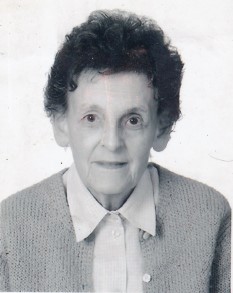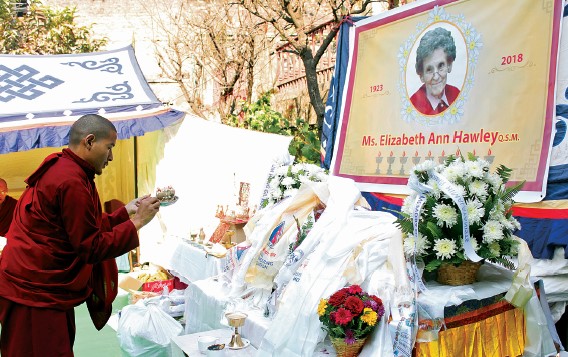“You go to your hotel, and as you are checking in, the phone is ringing, and the man behind the desk says, ‘Hawley wants to talk to you.’ You’ve barely put your bags down,” American mountaineer, Ed Viesturs, to Outside Magazine.
 Back in the late 90s, I was out looking for statistics related to Mt. Everest for an article I was writing on the world famous peak. “Go to Liz Hawley and you can get all the details from her,” said one official casually. Surprised as I was, I called Miss Hawley’s office in Dilli Bazaar to fix an appointment, but she answered the phone herself, and when she realized that I was looking for information on Everest, suddenly asked, “What do you want to know?” All I could blurt out was, “How many people have successfully climbed the peak?” She shot back instantly, “Eight hundred-and-eight people have climbed 1052 times; what else do you want to know?” Totally unprepared for such a response, I politely said, “Thank you so much ma’am,” and hung up. That was my introduction to the indomitable lady who rarely let an expedition slip by without interviewing the climbers. She was 75 at the time, and I was instantly in awe.
Back in the late 90s, I was out looking for statistics related to Mt. Everest for an article I was writing on the world famous peak. “Go to Liz Hawley and you can get all the details from her,” said one official casually. Surprised as I was, I called Miss Hawley’s office in Dilli Bazaar to fix an appointment, but she answered the phone herself, and when she realized that I was looking for information on Everest, suddenly asked, “What do you want to know?” All I could blurt out was, “How many people have successfully climbed the peak?” She shot back instantly, “Eight hundred-and-eight people have climbed 1052 times; what else do you want to know?” Totally unprepared for such a response, I politely said, “Thank you so much ma’am,” and hung up. That was my introduction to the indomitable lady who rarely let an expedition slip by without interviewing the climbers. She was 75 at the time, and I was instantly in awe.
Born in Chicago, Illinois on November 9, 1923, and educated at the University of Michigan, Elizabeth Ann Hawley first arrived in Kathmandu in February 1958 as a correspondent for Time/Life, assigned to cover the major changes the country was going through since King Tribhuvan’s triumphant return to power in 1951, and his untimely death in 1955. King Mahendra had ascended to the throne, and Miss Hawley was present at Hanuman Dhoka on February 12, 1959, when he handed over the constitution to General Subarna Shumsher Rana, paving the way for elections and the introduction of democracy to the kingdom of Nepal. She returned to Kathmandu in 1960 and rented a room in Dilli Bazaar, where she was to spend her entire life, and also set up her office there. And, that is where I met the slim, feisty lady for the first time to write my first article for ECS; about her.
This time I had an appointment, and as usual, reached there a little ahead of time. When my watch showed nine o’clock, I climbed up the stairs to enter her office on the first floor. “Oh, you are on time!” was the first thing she said in a strong, clear voice, looking a bit surprised. “In fact, you’re two minutes early.” That said it all. It seemed as if she was going to store that piece of information in her head for future reference. She turned out to be quite friendly during the interview, although some friends had warned me of how tough she was. She was surprisingly helpful when told that I would be writing an article on expatriates who’d lived in Nepal for several decades, providing me with names and phone numbers from her little diary.

When climbers arrived for an expedition, Hawley would be there in her work horse, the blue Volkswagen Beetle that she drove herself until age forced her to hire a driver. She made it a point to meet the mountaineers before and after each expedition, and nobody dared deceive her; she would dig out the facts. She was an authority on climbing in the Nepal Himalaya, keeping detailed records and reporting for Reuters, Outside, American Alpine Journal, Climber (UK), Die Alpen (Switzerland),Vertical (France), Alpinist (USA) and others. It’s no surprise she was known as the ‘Chronicler of the Himalayas’; she compiled accurate records of more than 20,000 ascents on around 460 peaks in the Nepal Himalaya. She was multi-tasking long before computers came into our lives, working as Executive Officer for Sir Edmund Hillary’s Himalayan Trust Nepal, doubling as a consultant for Mountain Travel/Tiger Tops (later Tiger Mountain Group), and reporting regularly for international news media while also serving as Honorary Consul for New Zealand. She outlived most of her contemporaries, such as Elizabeth Mendies and Inger Lissanevitch, who like her also first arrived in the 1950s and made Nepal their home.
She would recall how in the early 60s the locals called her Anglesi, a word obviously derived from ‘English’, although she was American. Miss Hawley would talk of how she could buy a dokoful of oranges for a rupee, and how Putali Sadak would abruptly end before it reached Krishna Pauroti. “They weren’t connected back then, you know,” she would remark. “And, all Nepali men wore daura suruwal, while the women folk remained indoors,” she would add looking back on her early days. Back then, she would ride a bicycle around town along the empty roads. Imagine a young Elizabeth coming down the Dilli Bazaar road on a bicycle with kids running after her shouting, “Anglesi! Anglesi!”
Liz Hawley spent more than half a century in Nepal, living through the reign of three Shah kings, and saw the kingdom transform itself into a true democracy, all from her humble abode in Dilli Bazaar. Her biography, I’ll call you in Kathmandu: The Elizabeth Hawley Story, by Bernadette McDonald, was published in 2005 and reprinted later as Keeper of the Mountains. Her meticulously compiled statistics on Himalayan expeditions is available in print and on a website as The Himalayan Database. Her well-kept records of political goings on in Nepal (post -1960) also resulted in two volumes of The Nepal Scene: Chronicles of Elizabeth Hawley 1988-2007 published in 2015. A 6,182-meter mountain peak has been named after her, and one hopes someone will have the good sense to honor her by naming a street after her, as well. During her lifetime, she received many awards both here and abroad, including an Honorary Queen’s Service Medal from Queen Elizabeth II, and became the first recipient of the Sagarmatha National Award from the Government of Nepal.
In her 90s, Hawley was in and out of hospital care, fighting various illnesses, until she succumbed to pneumonia on January 26 at the CIWEC Clinic Medical Center, aged 94. She remained single, and thus was known to many simply as Miss Hawley. She commanded great respect and is mourned by mountaineers around the world. Even renowned climbers like Reinhold Messner relied on her for accurate information. Her departure has created a vacuum that cannot possibly be filled, but she leaves behind an invaluable legacy: a mountain of information. Her exemplary dedication, enthusiasm, and commitment to keeping records on Himalayan expeditions presented a unique gift to the nation. Thank you Miss Hawley! We will miss you.










